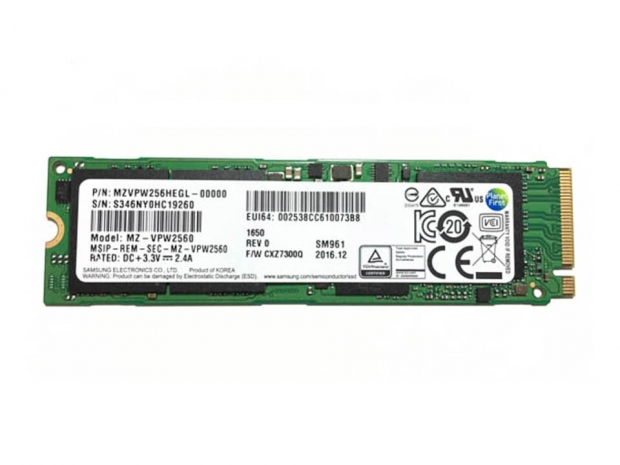Index
Conclusion – Great price to performance value
Samsung is now in its third generation of M.2 NVMe SSDs for OEMs and consumers, having first introduced its XP941 in May 2014, followed by the SM951 series in April 2015. On its 256GB drives, data throughput over the past two generations has increased 265 percent for reads and nearly 50 percent for writes, while IOPS performance has jumped 2.7 times for random 4K reads and 3.9 times for random 4K writes. The drives still have not quite reached the limitations of the PCI-E 3.0 x4 interface (3.94GB/s) but are likely to get within range by the time NVMe releases a new specification update.
In today’s market, most consumers still tend to use an SSD as a boot drive due to higher price-per-GB costs over traditional SATA storage drives, which often serve as storage for non-mission critical files and programs. Now that Samsung’s latest 256GB drives can hit top of the market speeds for under $150, we figured this would be a great capacity to test for an audience of mainstream consumers interested in replacing SATA and PCI-E based AHCI units with affordable NVMe storage options.
In our chart on the Specifications page, though we have the drive listed at a price of $161.10 with a price-per-gigabyte rating of $0.63, we managed to acquire it for just $147.77 from an eBay wholesale listing just last week.
In that regard, the Samsung SM961 256GB M.2 NVMe drive outperforms most PCI-E SSDs on the market with up to 3,100MB/s sequential reads, 1,400MB/s sequential writes, and up to 330,000 random read IOPS and 280,000 random write IOPS.
Intel’s SSD 750, while offered in a baseline 400GB model (SSDPEDMW400G4X1), manages 2,500MB/s sequential reads and 1,200MB/s sequential writes, yet still outperforms Samsung’s drive on random performance with 460,000 random read IOPS and edges it out with 290,000 random write IOPS.
MyDigitalSSD BPX 240GB (MDNVME80-BPX-0256), a double-sided M.2 2280, manages 2,600MB/s sequential reads and 1,300MB/s sequential writes, yet random performance takes a hit at 150,000 random read IOPS and 265,000 random write IOPS.
Then there is the OCZ RD400 256GB (RVD400-M22280-256G), which manages 2,600MB/s sequential reads and 1,150MB/s sequential writes, yet random performance shows a similar story at 210,000 random read IOPS and 140,000 random write IOPS.
Samsung SM961 or Samsung 960 EVO?
Perhaps one of the more interesting questions that consumers might inquire about are the differences between the OEM and consumer versions of Samsung’s Polaris-based NVMe SSDs. The SM961 uses 64-layer MLC V-NAND and features end-to-end data protection during power loss, while the consumer 960 EVO uses less durable 64-layer TLC V-NAND yet supports AES 256-bit user data encryption, TCG/Opal and dynamic thermal throttling. Of course, there is also a self-encrypting drive (SED) variant of the SM961, but this model seems more exclusive to OEMs as we have not been able to locate it in retail listings.
Much of our conclusion came down to differences in firmware support and performance. The SM961 firmware, and any of its OEM drives for that matter, do not support Samsung Magician software, a useful utility that enables firmware information reports, NAND cell life and endurance information, and the company’s famous DRAM cache feature called Rapid Mode. While some consumers might find these features particularly helpful for diagnosing issues or receiving the latest updates, there are always third-party utilities such as CrystalDiskInfo that can provide most relevant product data, and sites such as win-raid.com and similar communities can usually provide the most up to date firmware list.
On the bright side, a fresh installation of Windows 10 Anniversary Update took less than 3 and a half minutes to install in UEFI mode on this drive, while boot times of just 13 seconds are no small accomplishment for an SSD around the size of a stick of gum.
Pricing
As of February, pricing seems to be the biggest variable in choosing whether to purchase an SM961 OEM drive or wait for the 960 EVO to hit commercial availability. While we managed to find the OEM drive for $146.47 on eBay. Samsung’s 960 EVO consumer variant is expected to become widely available in just six weeks for $129.99. Given the main differences of MLC vs TLC V-NAND, drive encryption options, and a mostly unnecessary thermal throttling feature, we admit that both drives are worth considering and will prove their most effective feature to be an improvement in access times and lower latencies over similar AHCI-based PCI-E drives.




